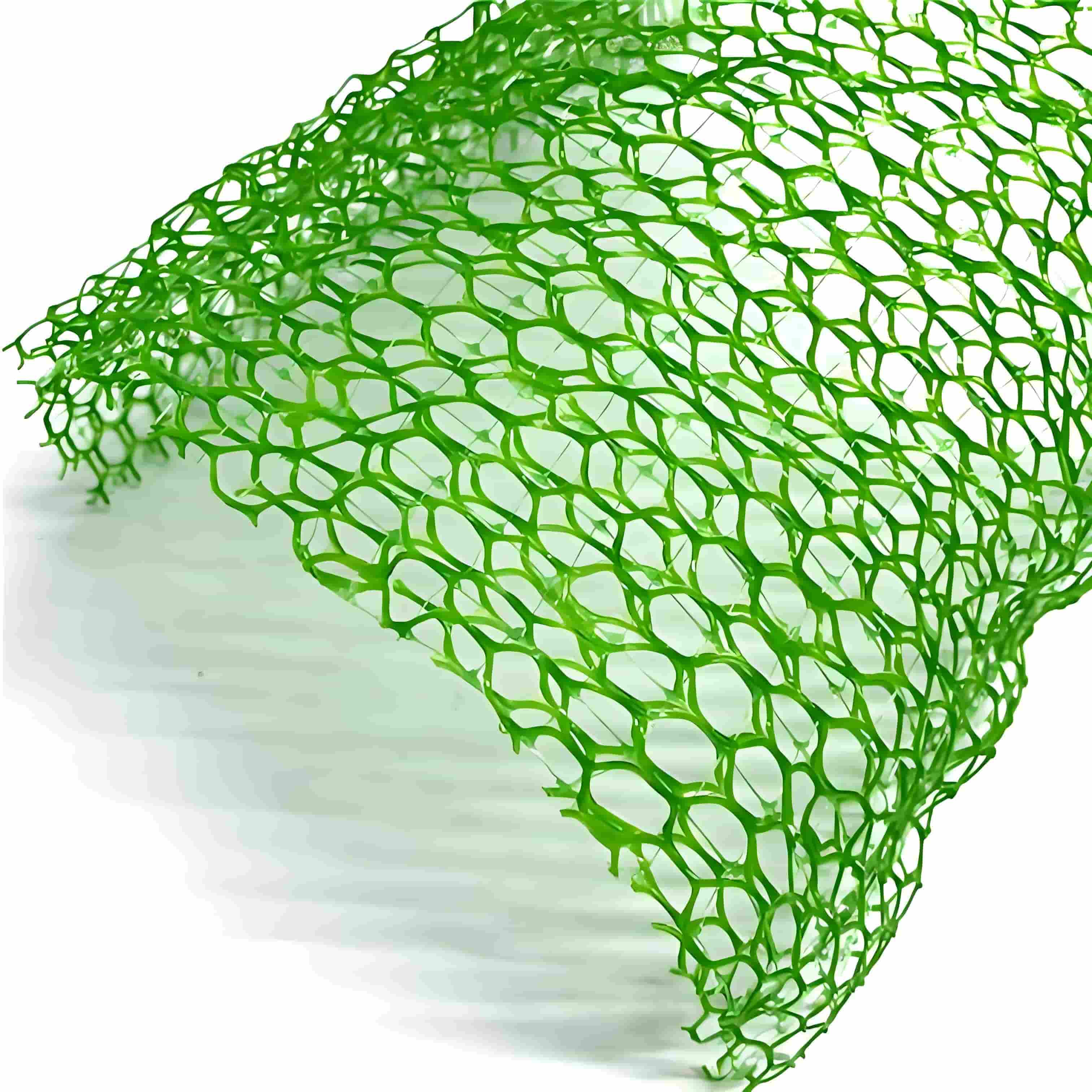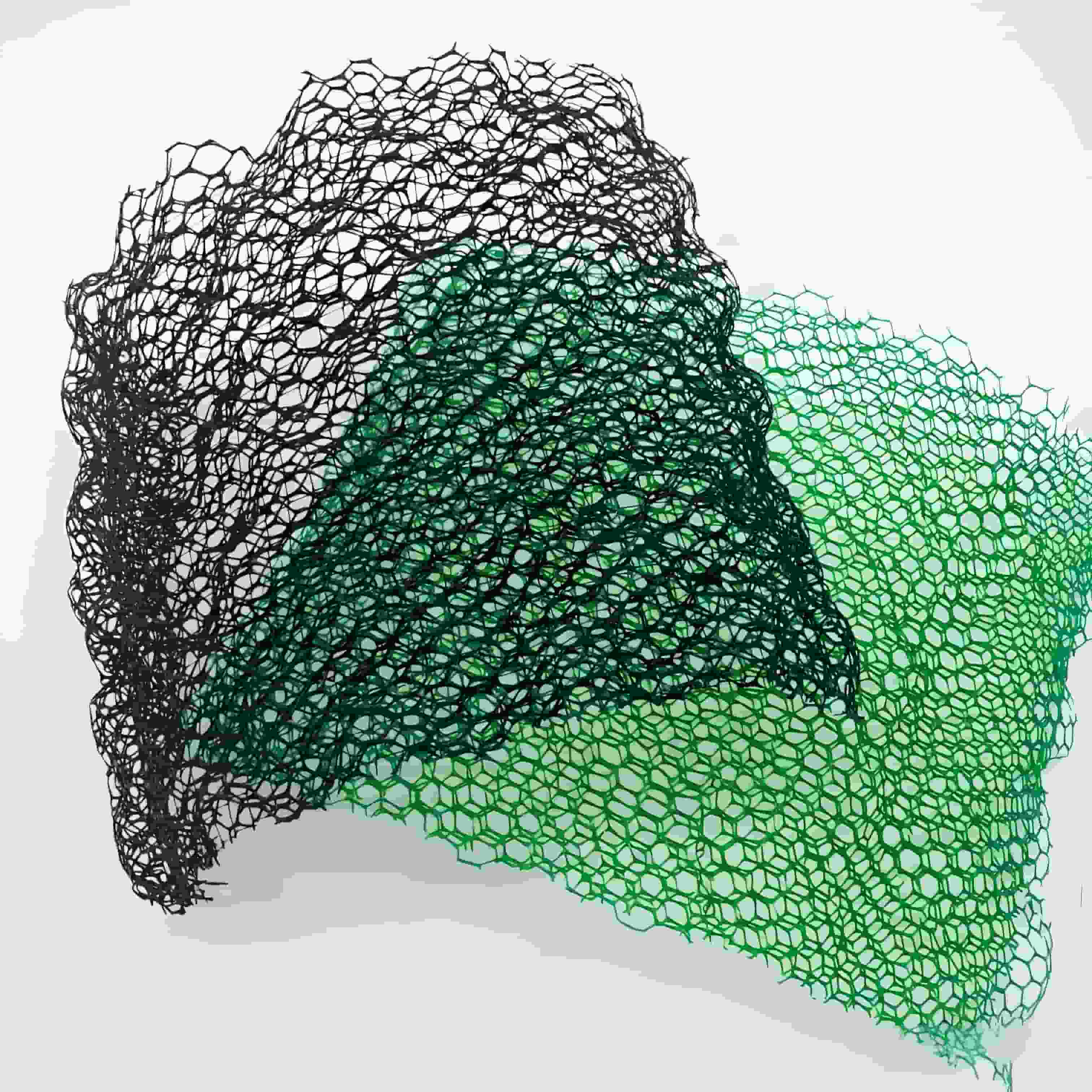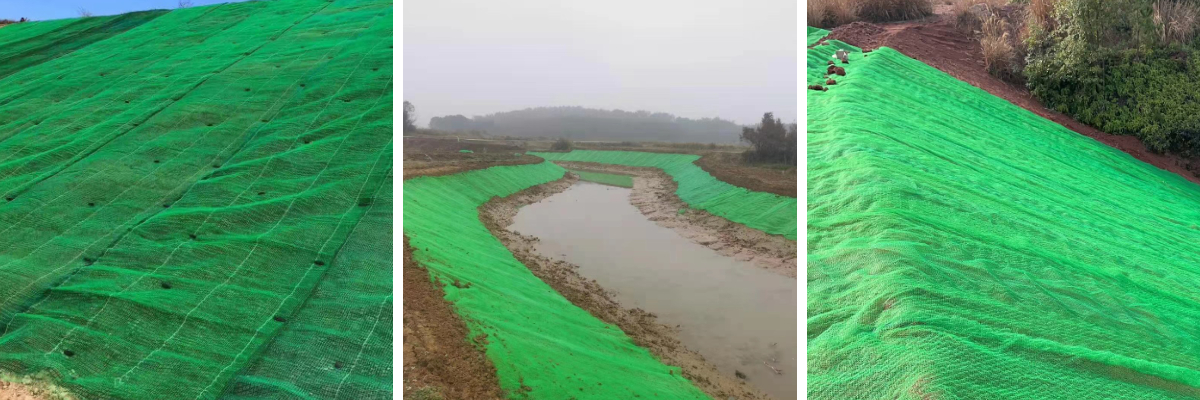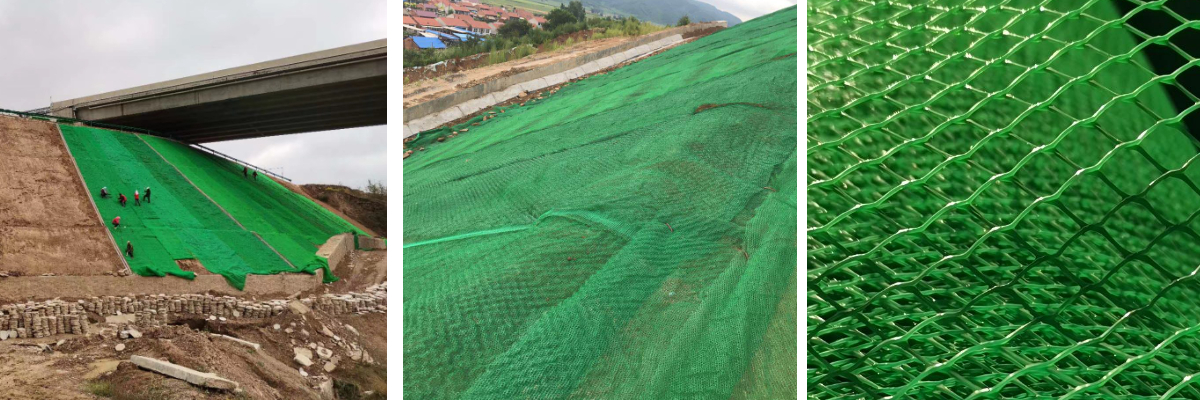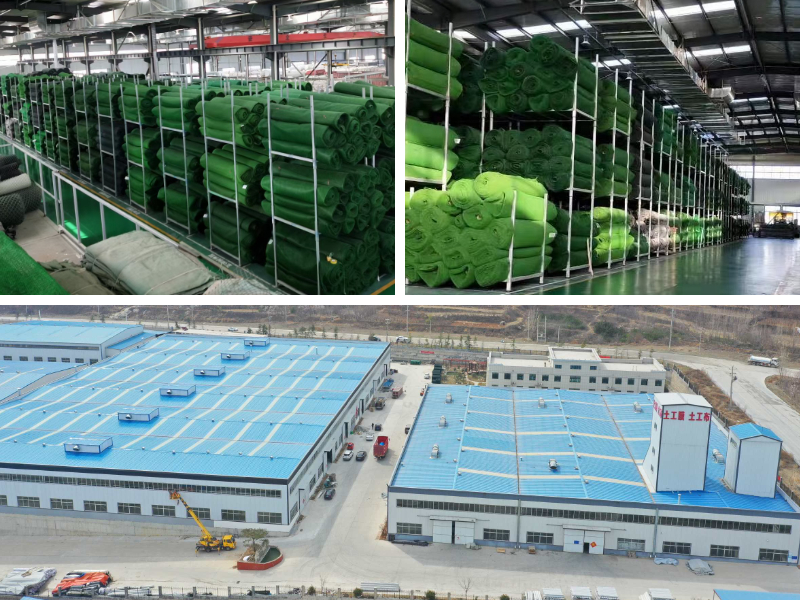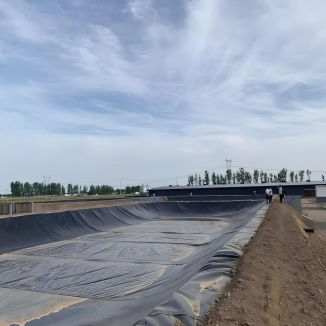Hydromulching With 3D Net
1.Structural Reinforcement: The three-dimensional grid enhances the soil - fixing ability, conforms to the slope surface, resists tension and tearing, and is suitable for steep slopes and complex terrains.
2.Eco - promotiveness: Provides growth space for plant roots, fixes hydro - mulching materials (seeds, fibers, etc.), and improves the survival rate of vegetation.
3.Erosion resistance: Disperse the impact force of water flow, reduce sediment loss, withstand extreme environments such as heavy rain and freeze - thaw cycles, and be stable and durable in the long term.
4.Construction Efficiency: The texture is flexible and easy to lay. It can be operated mechanically and constructed simultaneously with hydroseeding, shortening the project cycle.Cost and Environmental Protection Reduce the late
Product Introduction:
Hydromulching With 3D Net is a three-dimensional stereoscopic reticular geosynthetic material made of polymer materials such as polyethylene (PE) and polypropylene (PP) as the base material through hot melting or extrusion processes.
Three - dimensional Grid Structure: Composed of multiple layers of criss - cross grids, forming a three - dimensional spatial structure with a height of 5 - 15mm. The pores are evenly distributed, and the pore diameter is usually 5 - 15mm.
Balance between Flexibility and Strength: The material has a low density (about 0.9 - 0.95g/cm³), but its tensile strength can reach 10 - 20MPa, and the elongation at break is ≤300%. It can adapt to the undulating deformation of the slope surface.
Core functions and technical advantages
1.Soil fixation and erosion resistanceThe three - dimensional structure forms "miniature retaining walls", intercepts the sediment in the water flow, reduces the sediment - carrying capacity of runoff on steep slopes (≥30°) by more than 70%, and the anti - scouring ability is increased by 50% compared with two - dimensional nets.
2.Vegetation Growth SupportThe grid provides climbing space for plant roots, forming a "root - mesh" composite reinforcement system, which is especially suitable for the ecological restoration of rocky slopes or infertile soil.
3.Ease of constructionIt can be laid by machinery or manually stretched, and can be constructed simultaneously with hydraulic covering (spray seeding), adapting to complex terrains such as mines and highways.
Product Parameters:
Item | EM2 | EM3 | EM4 | EM5 |
Unit mass per area / (g/m2) | ≥220 | ≥260 | ≥350 | ≥430 |
thickness /mm | ≥1O | ≥12 | ≥14 | ≥16 |
Width deviation /m | ±1.0 | |||
length variation /m | ±1 | |||
Longitudinal tensile strength/(KN/m) | ≥O. 8O | ≥1.4 | ≥2. O | ≥3. 2 |
Tensile strength in the transverse direction / (KN/m) | ≥O. 8O | ≥1.4 | ≥2. O | ≥3. 2 |
Product Applications:
1.Slope Protection Project
Highway and Railway Slopes
Application Scenarios: Deep-cut slopes of expressways, railway cutting slopes (such as the desert section of the Beijing-Xinjiang Expressway and the mountainous section of the Chengdu-Kunming Railway).
Technical Advantages: The combination of three-dimensional nets and sprayed grass seeds forms a "net - vegetation" double-layer protection, reducing the landslide risk caused by rainwater scouring. For example, after a 3mm-thick three-dimensional net was used on a mountainous highway slope, the runoff sediment volume decreased by 80%, and the vegetation coverage rate reached 60% within 6 months.
Mine slope restoration
Rocky mine pit treatment: Lay a three-dimensional net on the bare rock wall, and spray and sow planting soil containing water-retaining agents and shrub seeds. For example, in the case of the abandoned slope of a coal mine in Shanxi, a stable vegetation layer was formed after 2 years, and the soil loss decreased by 90%.
Tailings dam protection: The three-dimensional net fixes the tailings sand, preventing wind dust and rainwater erosion, and at the same time provides a growth base for drought-tolerant plants.
2.Eco - soil and water conservation project
River channels and reservoir bank slopes
Riverbank protection dikes: Lay three - dimensional nets on the river - eroded banks, combined with the planting of aquatic plants (such as reeds and calamus), which not only stabilizes the bank slopes but also purifies the water quality. For example, in the treatment of a tributary in the middle and lower reaches of the Yangtze River, the three - dimensional net increased the anti - erosion flow velocity of the bank slope from 2m/s to 3.5m/s.
Reservoir drawdown zone: The water - resistant three - dimensional net (anti - aging PP material) adapts to the periodic rise and fall of the water level, preventing soil loss in the drawdown zone.
Desertification and Wasteland Treatment
Fixing of Sand Dunes: Cover the mobile sand dunes with a three - dimensional net to reduce the wind speed (the wind speed near the net surface drops by 40%), fix the sand grains and provide a seeding carrier for psammophytes (such as Haloxylon ammodendron and Artemisia sphaerocephala).
Improvement of Saline - alkali Land: The three - dimensional net blocks the rise of capillary water in the soil, reduces the surface salt accumulation, and cooperates with the planting of salt - tolerant plants to improve the improvement efficiency.
3.Special Environments and Municipal Engineering
Frost-Thaw and High-Altitude Regions
Railway slope: The cold-resistant three-dimensional net (remaining flexible even at -40℃) buffers the soil frost heaving stress, prevents the subgrade slope from cracking, and at the same time retains snow through its mesh holes, reducing soil moisture loss.
Plateau Ecological Restoration: In areas above 4,000m altitude, the three-dimensional net resists strong ultraviolet rays (UV protection level ≥ 5), providing shelter for plateau meadow seeds.
Municipal Greening and Roof Gardens
Vertical Greening: Fix the three-dimensional net on the building facade, spray the substrate of climbing plants (such as Boston ivy) to achieve wall greening, heat insulation, and noise reduction.
Roof Planting: Lay a lightweight three-dimensional net (1.5mm thick) on the roof waterproof layer, fix the planting soil and guide the root distribution to prevent waterlogging and leakage.
4.Hydraulic and Agricultural Engineering
Terrace and Farmland Soil and Water Conservation
Lay a three-dimensional net along the contour lines of sloping farmland to form a micro - storage structure, reducing the scouring of rainfall runoff and reducing the soil loss of terraces by more than 60%.
Protection of Reservoirs and Irrigation Channels
Lay three-dimensional nets on the slopes of the channels to prevent the collapse of the channel banks caused by water erosion and reduce seepage losses at the same time. This is applicable to the farmland water conservancy projects in arid areas.
Through the dual functions of "engineering reinforcement + ecological restoration", the three-dimensional net solves the problems of easy aging and poor ecological performance of traditional hard protection in slope protection, soil and water conservation, and special environment treatment. It is especially suitable for projects that need to balance safety and ecological benefits. The selection of its materials needs to consider factors such as terrain slope, climate conditions (precipitation, ultraviolet intensity), and vegetation type to achieve the optimal protection effect.


